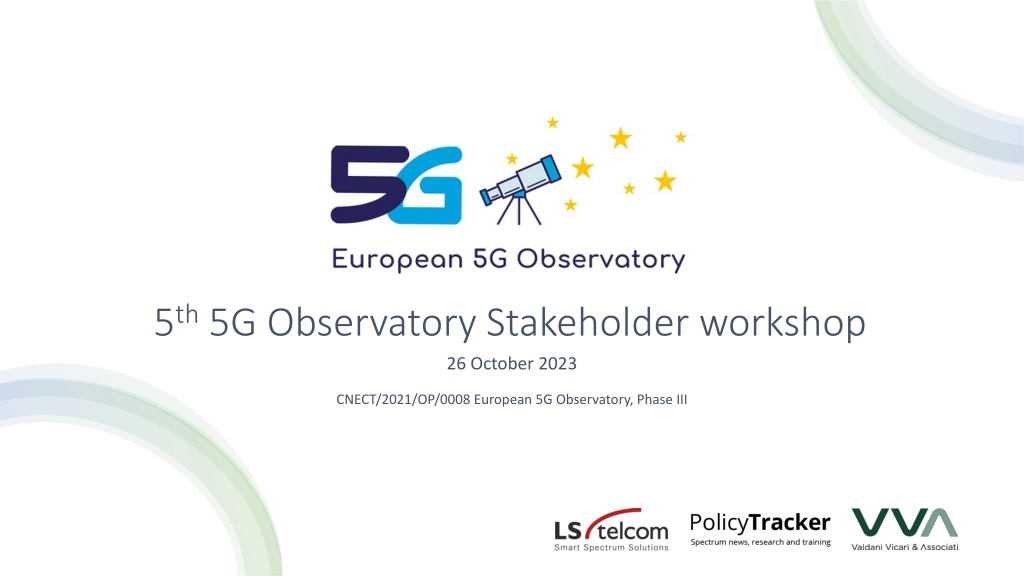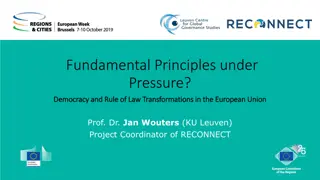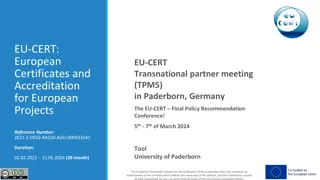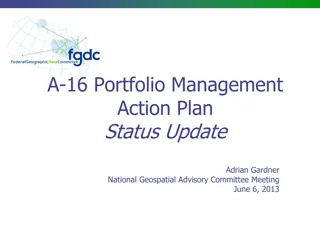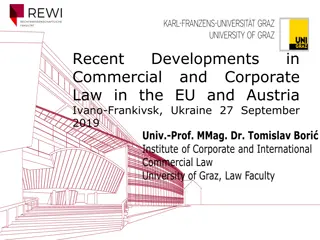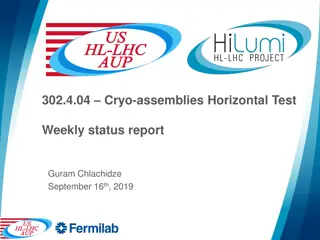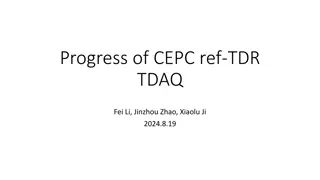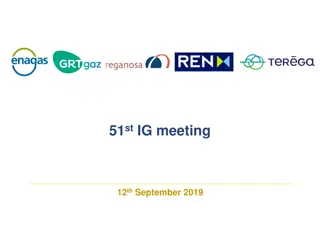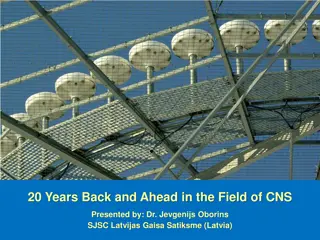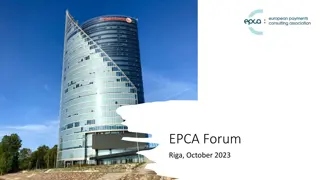European 5G Developments and Progress Update
Recent updates on 5G spectrum policy, pioneer band assignments in the EU, new 5G KPIs, cross-border projects, public funding initiatives, and commercial developments. The average 5G coverage is expanding, with varying end-user experiences, and efforts are ongoing to improve 5G networks across Europe.
Download Presentation

Please find below an Image/Link to download the presentation.
The content on the website is provided AS IS for your information and personal use only. It may not be sold, licensed, or shared on other websites without obtaining consent from the author. Download presentation by click this link. If you encounter any issues during the download, it is possible that the publisher has removed the file from their server.
E N D
Presentation Transcript
5th 5G Observatory Stakeholder workshop 26 October 2023 CNECT/2021/OP/0008 European 5G Observatory, Phase III
Recent developments: Spectrum policy Date Country Spectrum awarded Recent developments: Spectrum policy Nov. 2022 Estonia 700 MHz 700 MHz 1500 MHz 2.6 GHz 3.6 GHz 700 MHz 2.1 GHz 2.3 GHz 2.6 GHz 26 GHz 800 MHz 900 MHz 1800 MHz 2.1 GHz 2.6 GHz 3.6 GHz* 26 GHz 900 MHz 2.1 GHz 2.6 GHz 3.6 GHz Nov. 2022 Romania Various spectrum auctions took place All Member States have now assigned at least one pioneer band, and the majority have assigned at least two (24 MS total) 26 GHz remains unpopular: Only 11 MSs have assigned band Local 5G licensing models continue to be proposed (Poland, Slovenia) Dec. 2022 Ireland Jan. 2023 March 2023 Spain Croatia May 2023 Sept.2023 Estonia Sweden Oct. 2023 Poland *Regional licenses
Recent developments: Spectrum policy Pioneer bands assigned in the EU (700 MHz; 3.6 GHz; 26 GHz) October 2023 October 2022 62% assigned 71% assigned
Recent developments: Policy Recent developments: Policy June 2023: New 5G Key Performance Indicators (KPIs) announced by Commission New KPIs will measure the percentage of households that receive a 5G signal independent of the operator or service quality Ongoing effort by the Digital Decade Committee to improve this metric in the future 5G cross-border progress January 2023: 15 cross-border project winners announced as part of 1st call of Connected Europe Facility (CEF) Winners of the 2nd call will be announced end of November 3rd call open now until January 2024 Public 5G/6G funding continues January 2023: France issues 750 million call for 5G and 6G projects March 2023: Belgium funds 21 pilot 5G projects May 2023: Lithuania allocates 24.5 million for 5G projects June 2023: Spain makes 500 million available for rural 5G
Recent developments: Commercial Recent developments: Commercial Average 5G coverage now stands at 81% (by at least one operator) Operators are increasing coverage and investing in new technologies Vodafone & Telefonica Germany claim 90% 5G coverage (Deutsche Telekom 95%) Telia group 5G coverage at 84% across its six European markets However, end-user 5G experience varies No reliable data on standalone 5G Difficult to measure the quality of 5G networks Photo by Julian on Unsplash
Major international developments Major international developments The 5G Observatory also keeps track of major international 5G developments Growing interest in standalone 5G (SA) and network slicing GSA: 121 operators in 55 countries investing in 5G SA (47 operators have launched 5G SA) August 2023: US-based T-Mobile launches network slicing beta Indian MNO Jio to use network slicing for 5G fixed wireless access (FWA) Rapid 5G growth in India: Department of Telecommunications claims over 300,000 base stations only a few months after spectrum auction Source: GSA
EU Scoreboard 81%5G coverage of populated areas1 71%of pioneer bands assigned on average in EU27 (Each pioneer band is weighed 1/3rd)3 5G deployment & coverage 5G spectrum assignments Darker green indicates higher coverage Reporting period: Up to end-2022 Reporting period: Up to October 2023 346,000 5G base stations in EU27 5G base stations as a percentage of existing 4G base stations2 5G pioneer bands assigned across the EU27 Reporting period: Up to October 2023 Reporting period: Majority of entries collected between Aug. Oct. 2023; see footnote for more detail
EU Scoreboard 5G base stations as a percentage of existing 4G base stations in Member States5 EU 5G progress Reporting period: Majority of entries collected between Aug. Oct. 2023; see footnote for more detail
75G cross border works 8 5G cross border studies 5G Corridors Reporting period: Up to end-2022
EU 5G Corridors Committed investment in 5G cross-border deployment 5G Corridors Source: European Commission Reporting period: Up to end-2022
International Scoreboard International Scoreboard Comparison of 5G rollout in international markets6 5G rollout Reporting period: 5G base station data collected between July 2022 July 2023; Population data collected July 2023; 5G subscriber data collected between July 2022- July 2023
International Scoreboard International Scoreboard Main bands authorised for 5G in international markets7 Authorised 5G spectrum in international markets7 5G spectrum Reporting period: Up to Sept. 2023
5G Private networks update EU The Observatory maintains a non-exhaustive list of private 5G networks which is based on research of publicly available information. The Observatory team endeavour much information on published private 5G network deployments as possible. The analysis from the last quarterly report can be found on the website here. An overview of 5G private searchable table (on the right) of major private network projects in the EU can be found here. Research the latest public 5G networks in EU countries Public search yields announcements from major vendors (e.g. Ericsson, Nokia), verticals themselves The 5G Observatory s list of networks includes a short summary including the main applications being supported to obtain as networks featuring a announcements of private telco involvement or
5G Private networks update EU Private 5G networks in EU-27 20 Deployment of 5G private networks has continued to increase across EU countries in the past 12 months. A total of 94 networks with Germany (20), France (13) and Finland (8) as leading MSs Demand for networks is based on the need for dedicated secure services to private enterprises as factories, campuses, ports and airports 18 16 Count of private 5G networks EU-27 14 12 10 8 these private 6 4 such large 2 plants, 0 DISCLAIMER: There are more 5G private networks deployed in practice, noting the data is based on search of publicly announced deployments and subject to continuous change.
EU = 37% of global (GS) deployments 5G Private networks update EU Outside of the EU, countries including Japan, UK, China and the USA have a large proportion of total 5G private networks globally (Source: GSA) Our research indicates that 5G private networks are being deployed in dedicated spectrum (e.g Germany) Some current 4G networks will be upgraded to 5G in due course Many of the applications being deployed include: High-definition video links Low latency comms for vehicle control Industry 4.0 applications Secure, predictable and accessible wireless digital infrastructure A key attribute is 5G private networks are independent of loads on public or unlicensed networks Source: Private Mobile Networks, September 2023, GSA Total Global deployments = 676
5G Private networks update EU Nokia and Ericsson are the main vendors deploying 5G private networks in the EU Telcos deploying 5G private networks include Vodafone, Deutsche Telekom, Telefonica, T-Mobile, A1 Austria, Proximus, Orange, TDC Net and B2B operator CityMesh among others In most of the telco-deployed networks, MNOs are using their 5G spectrum (mostly in 3.4 3.8 GHz); in some cases the initial deployment is using 4G and equipment is 5G-ready
5G Deployment Forecasting progress towards 2025 ERICSSON, Mobility Report, June 2023. Scope: Global BR 19 Western Europe 4G technology is reported to be still dominant in Western Europe, with the subscription penetration reaching 79% at the end of 2022. 5G subscriptions experienced strong growth, moving from 32 million in 2021 to 69 million at the end of 2022. 5G subscriptions are expected to reach 143 million by the end of 2023 (a reduction of 7 million by comparison to last year's forecast), with a subscription penetration projected to reach 88% by 2028. Central and Eastern Europe In Central and Eastern Europe, the uptake is slower due to both the reluctance of consumers to upgrade to more expensive subscriptions and slower spectrum allocation processes. 4G subscriptions accounted for 73% of the market at the end of 2022, but the growth has flattened and should be close to zero until 2025. Nevertheless, from 2025 onwards, only 5G subscriptions are projected to be growing. Source: Ericsson, Mobility Report, 2023
5G Deployment Forecasting progress towards 2025 GSMA, The Mobile Economy, 2023. Scope: Global BR 18 In 2022, 5G technology comprised 11% of the market in Europe, representing an increase from the 4% figure in 2021, whereas 4G still accounted for 75% of the market. By 2030, 5G uptake is projected to grow to 87% with a reduced 4G market share of 13%. Furthermore, overall mobile subscriber penetration is expected to only marginally increase from 90% in 2022 to 92% by 2030, accompanied by a moderate rise in smartphone adoption from 81% in 2022 to 91% by 2030. Source: GSMA, The Mobile Economy Report, 2023
Next generation networks contribution to reaching Green Deal targets and addressing sustainability issues Commitments taken up by the industry to reduce emissions and the role of 5G in the context of the targets set by the Green Deal ETNO (European Telecommunications Network Operators Association): State of the Digital Communications 2023 BR 18 ETNO emphasised the focus on the greening of telecoms networks through the transition toward next-generation networks. 4G and 5G networks are more energy efficient and, thus, their rollout is crucial for reducing energy usage. Most ETNO members are planning to shut off their 3G networks by 2028 and 2G networks will follow thereafter due to their importance for IoT functions and basic voice services. Five decommissioning dates per year were announced for legacy networks (PSTN) in 2017. This is due to increase to 10 in 2023 and 2024 and 11 in 2025 2030. Source: Analysys Mason, 2022, as reported in ETNO, State of the Digital Communications, 2023
Next generation networks contribution to reaching Green Deal targets and addressing sustainability issues Commitments taken up by the industry to reduce emissions and the role of 5G in the context of the targets set by the Green Deal Analysis Mason: Decommissioning legacy networks will be key to reducing operators energy usage, 2022 BR 18 Mobile network operators who are operating a full suite of 2G, 3G, 4G and 5G networks would be able to lower energy consumption by 40% by decommissioning 2G and 3G networks. Similarly, transitioning from legacy fixed networks (PSTN, copper, local exchanges, FTTC and HFC) to an all-FTTP access network could reduce operators energy usage by up to 80%. The upgrading process varies across fixed networks operators, featuring A1 Telekom Austria and Deutsche Telekom who has switched off PSTN, Telenor and Telef nica who will switch off their copper-based networks by 2025, and Proximus and KPN who are beginning to shut down their FTTC networks. Source: Analysys Mason, 2022
Next generation networks contribution to reaching Green Deal targets and addressing sustainability issues Commitments taken up by the industry to reduce emissions and the role of 5G in the context of the targets set by the Green Deal MWC (Mobile World Congress) Barcelona 2023 QR 18 From the private sector, and in companion with the 2023 MWC, several major telcos announced initiatives toward more sustainable 5G networks. Huawei launched their Eco series antennas, aiming to reduce site power consumption by 15%, as well as improving network energy efficiency, reducing OPEX and reducing carbon emissions. These antennas are supposed to bolster the development of green and high-performance 5G networks. ZTE is pursuing a higher 5G network energy efficiency by way of their AAU hibernation or zero-load zero-carbon technology, which reduces the energy consumption of their zero-load equipment. Ericsson showcased several new solutions in accordance with meeting their Net Zero ambitions during the MWC. The solutions focus on sustainability, energy saving and capacity expansion, and include portfolios such as new remote radios for 4G and 5G capacity, new mobile transport offerings and a new range of wideband Massive MIMO radios. All of which put an emphasis on lowering carbon emissions and site footprint.
